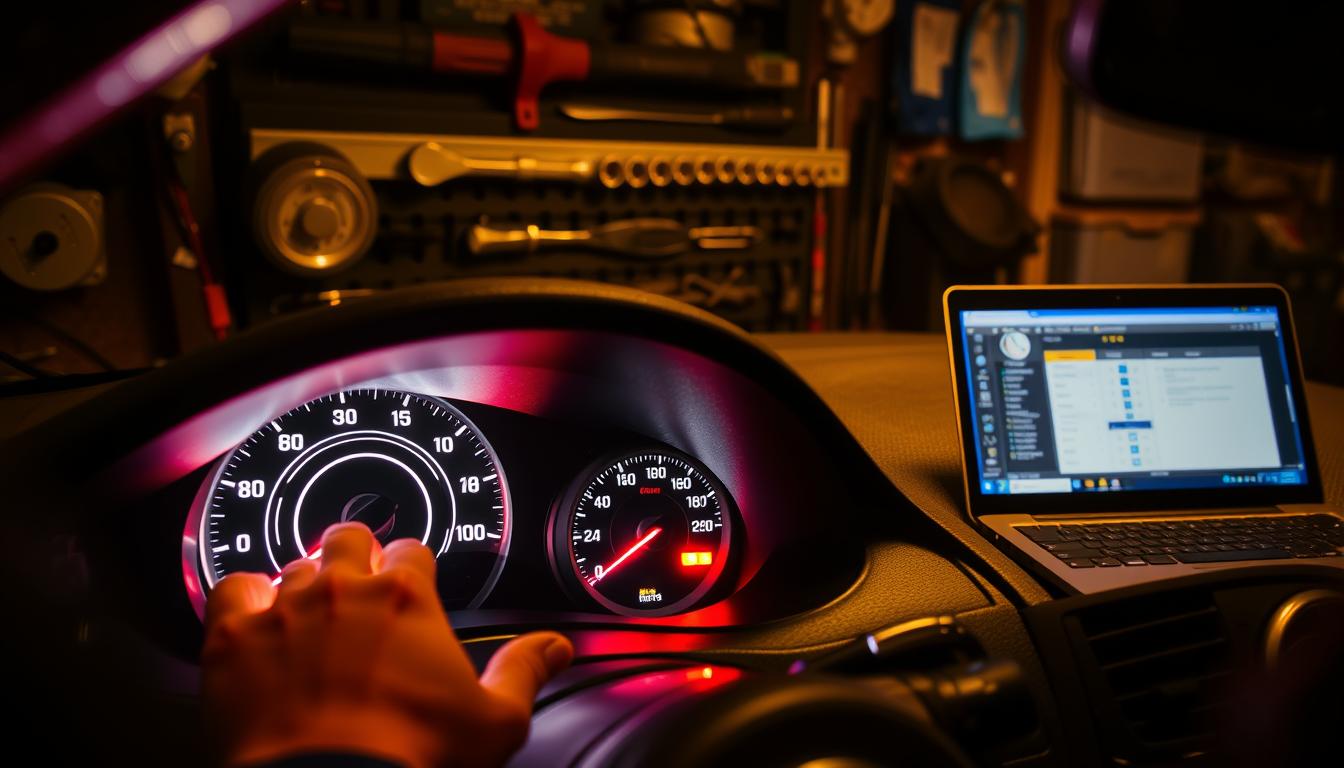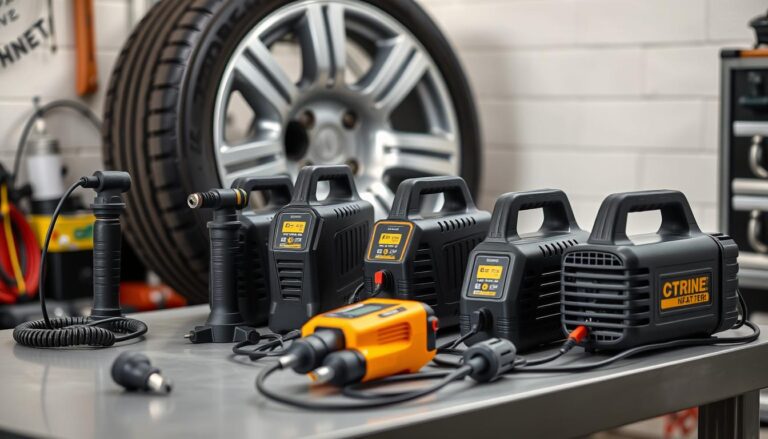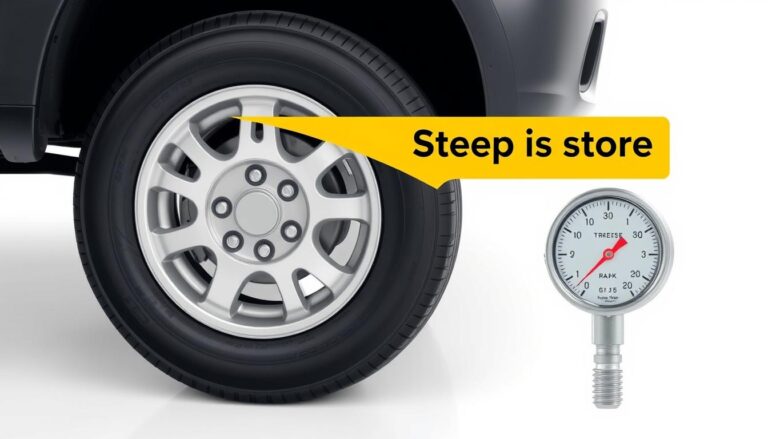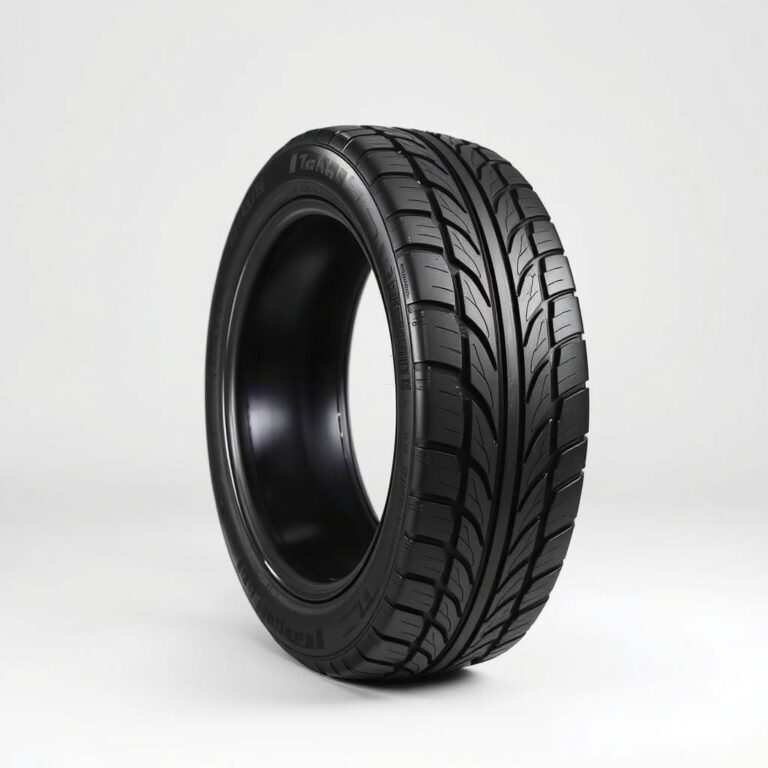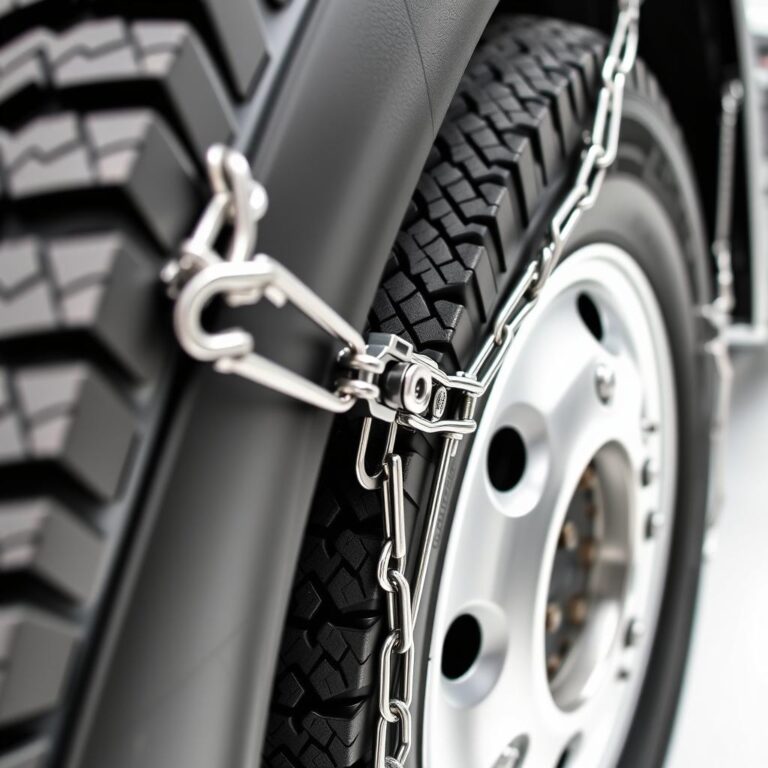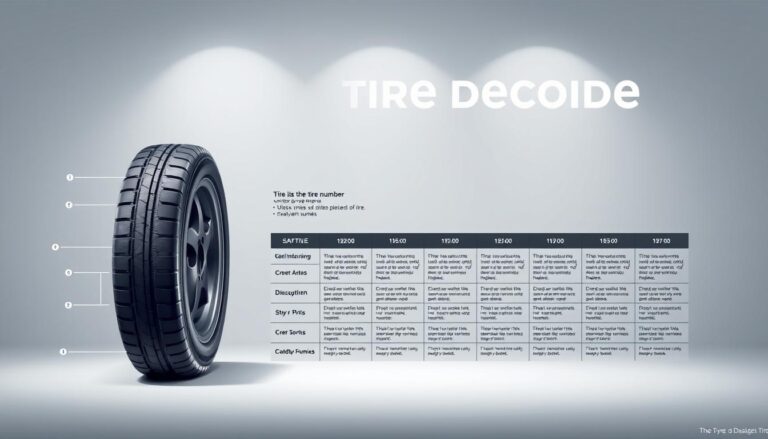Why Is My Tire Pressure Light Stil On After Filling Tires?
Many drivers in the United States face a frustrating issue. Their tire pressure light stays on even after they fill their tires. This problem can make drivers worried about their vehicle’s safety.
Modern cars have Tire Pressure Monitoring Systems (TPMS) to alert drivers to tire issues. But sometimes, the light won’t turn off, even if the tires are properly inflated.
The light might stay on for reasons other than low air pressure. Issues like sensor problems, temperature changes, or calibration errors can cause it. To figure out why your light is on, you need to diagnose and fix the problem.
Tire experts like Michelin suggest checking tire pressure often. They also advise understanding how your car’s warning system works. Ignoring the light can be risky, as it might point to safety or mechanical issues that need fixing right away.
This guide will look at why your tire pressure light might not turn off. We’ll offer practical tips and steps to help you fix the issue.
Understanding Your Vehicle’s Tire Pressure Monitoring System (TPMS)
Modern cars have a smart tire pressure monitoring system (TPMS). It keeps your tires in top shape and safe. This system checks tire pressure all the time and alerts you to any issues.
The tire pressure sensor is key to keeping your vehicle’s tires healthy. These sensors work hard to keep your tires at the right pressure. This can help avoid dangerous driving situations.
Direct vs Indirect TPMS Systems
There are two main types of tire pressure systems in cars:
- Direct TPMS: Uses sensors in each tire to check pressure
- Indirect TPMS: Checks pressure by looking at wheel speed and how the car moves
How TPMS Sensors Work
Tire pressure sensors send data to your car’s computer. If pressure gets too low, a light on your dashboard will turn on. This warns you of any tire problems.
Normal Operating Parameters
Most TPMS systems turn on when pressure drops 25% below what’s recommended. This early warning helps you fix tire issues before they’re serious.
Knowing how your TPMS works helps keep your tires in great shape. It also makes driving safer for you and others.
Why Is My Tire Pressure Light Stil On After Filling Tires: Common Causes
Seeing a tire pressure warning light can be really annoying. Even after you fill your tires, the light might stay on. It’s important to know why this happens to keep your car safe and running well.
There are a few main reasons for a tire pressure warning that won’t go away:
- Inaccurate tire inflation techniques
- Sensor malfunctions
- Temperature-related pressure changes
- Damaged or faulty TPMS sensors
To figure out why your tire pressure light is on, first check how you’re inflating your tires. Precision is key – use a reliable digital pressure gauge to make sure each tire is at the right PSI. If you inflate unevenly or incorrectly, the system will warn you.
TPMS sensors are very sensitive and can go wrong. A bad sensor might keep sending the wrong pressure signals, even after you’ve inflated your tires right. This could happen because of:
- Physical sensor damage
- Battery degradation
- Electronic communication issues
Temperature changes also affect tire pressure. Cold weather can lower it, while heat can raise it. These changes might be why your tire pressure warning light is on, even after you’ve filled your tires.
If you’ve checked your tire pressure and the light is not off, you might need a professional to find out what’s wrong. They can check your sensors and system for any problems.
Faulty or Dead TPMS Sensors
Tire pressure monitoring system (TPMS) sensors are key parts that can fail, leading to warning lights. Knowing the issues with these sensors helps car owners fix tire pressure problems.
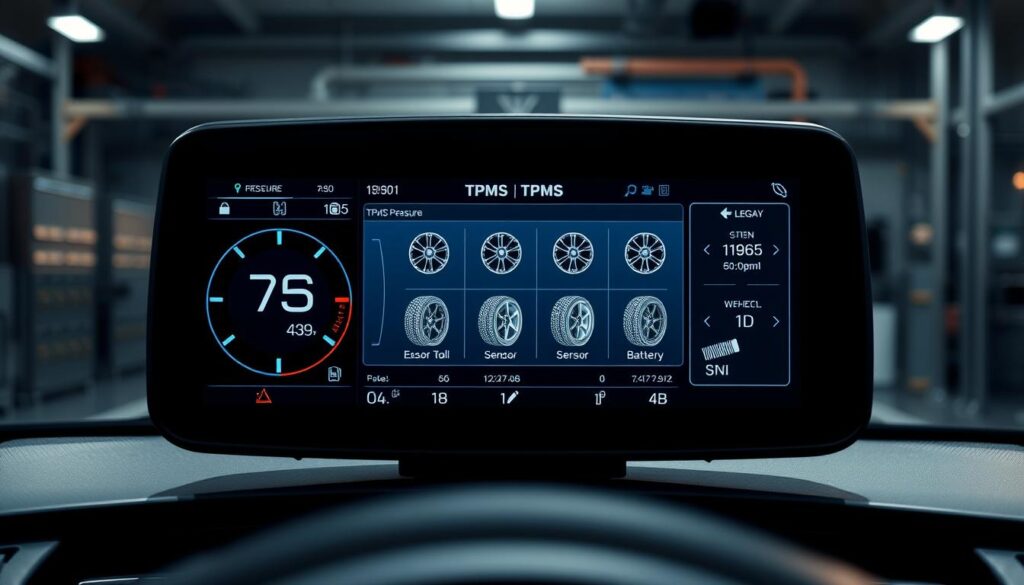
Battery Life and Replacement
Tire pressure sensors use small batteries that last 5-7 years. When these batteries wear out, they can send wrong signals or stop working. Drivers might see:
- Intermittent tire pressure warnings
- Constant illumination of the tire pressure light
- Sensor readings that fluctuate unexpectedly
Sensor Damage Signs
Physical damage to a tire pressure sensor can make it useless. Look for these signs of sensor trouble:
- Visible corrosion on sensor valve stems
- Bent or damaged sensor mounting
- Leaks around the sensor valve
Calibration Issues
Calibration problems can lead to wrong readings from your tire pressure monitoring system. You might need a pro to recalibrate after:
- Tire rotation
- Wheel replacement
- Sensor replacement
| Sensor Issue | Typical Symptoms | Recommended Action |
|---|---|---|
| Battery Failure | Inconsistent warnings | Replace sensor battery |
| Physical Damage | Constant pressure light | Replace entire sensor |
| Calibration Problems | Incorrect pressure readings | Professional system reset |
Keeping your tire pressure sensors in good shape can stop unexpected warning lights and keep tire pressure accurate.
Temperature Effects on Tire Pressure

Temperature is key in managing tire pressure. Seasonal changes can cause big swings in tire air pressure. Cold weather often leads to a low tire pressure alert, which can surprise car owners.
Knowing how temperature affects tire pressure is vital for good car performance. Every 10-degree Fahrenheit change in temperature can change tire pressure by about 1 PSI. This means tire pressure can drop in the cold mornings and rise in the warm afternoons.
- Cold temperatures cause air molecules to contract, reducing tire pressure
- Warm temperatures expand air molecules, increasing tire pressure
- Typical pressure change: 1 PSI per 10-degree temperature variation
Tire pressure changes are most obvious during big seasonal shifts. Car makers suggest checking tire pressure monthly and adjusting for big temperature changes to avoid safety risks.
| Temperature Range | Typical Pressure Change | Recommended Action |
|---|---|---|
| Below 32°F | Pressure Drops | Check and inflate tires |
| Above 90°F | Pressure Increases | Release excess air if needed |
Pro tip: Always check tire pressure when tires are “cold” – meaning the vehicle hasn’t been driven for at least three hours – to get the most accurate reading.
Proper Tire Pressure Checking Techniques
Keeping your tires at the right pressure is key for safety and performance. A good tire pressure gauge is a must-have for every driver. It helps avoid tire problems and keeps your car running smoothly.
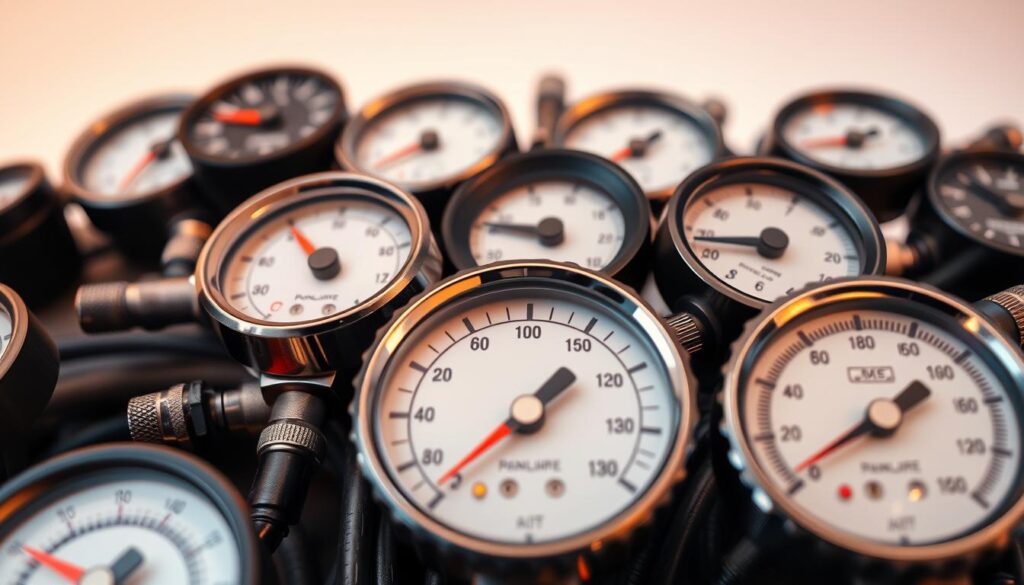
Drivers need to know how to check tire pressure the right way. The right methods can stop unexpected issues and make your tires last longer.
Digital vs Analog Tire Pressure Gauges
When picking a tire pressure gauge, consider a few things:
- Digital gauges give exact readings
- Analog gauges are reliable and simple
- Accuracy can vary between types
| Gauge Type | Accuracy | Price Range | Durability |
|---|---|---|---|
| Digital Gauge | ±0.5 PSI | $15-$50 | Medium |
| Analog Gauge | ±1-2 PSI | $5-$25 | High |
Best Time to Check Pressure
For the most accurate readings, check tire pressure when they’re cold. This means your car hasn’t moved for at least three hours or less than a mile at a moderate speed.
Recording and Monitoring
Make checking tire pressure a regular habit:
- Check pressure every month
- Keep a log of your readings
- Compare to the manufacturer’s suggestions
- Look for any steady changes in pressure
By following these steps, drivers can keep their tires in top shape. This helps prevent tire problems and keeps your car running well.
TPMS Reset Procedures for Different Vehicle Makes
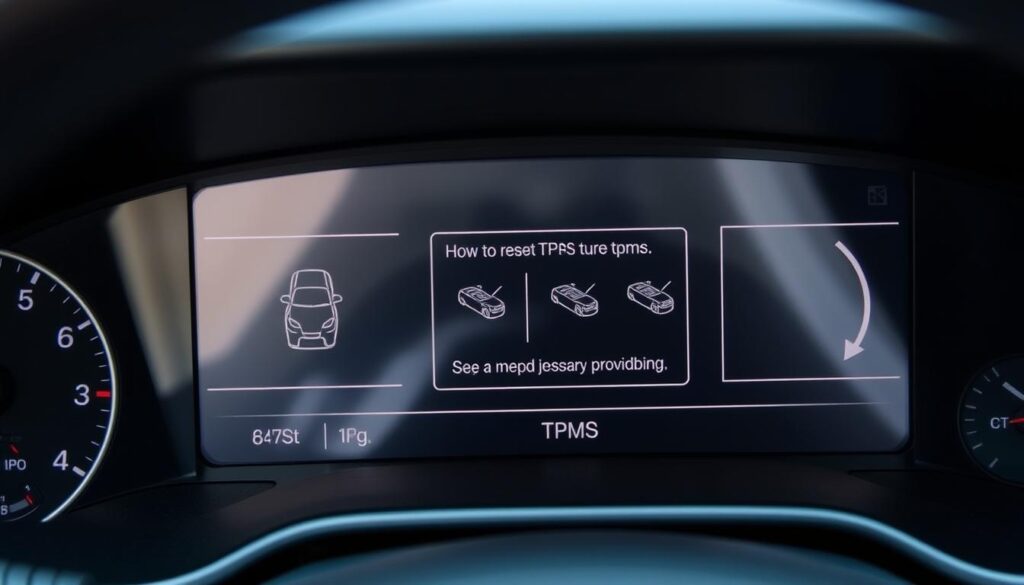
Resetting your tire pressure monitoring system (TPMS) is key after changing tires or maintenance. Each car maker has its own way to do this. Drivers must follow these steps carefully.
Modern cars need specific steps to reset the TPMS. These steps might include driving, using dashboard controls, or pressing certain buttons.
- Ford vehicles often require driving at speeds above 20 mph to reset TPMS
- Toyota models usually need a manual reset through the vehicle’s menu
- GM vehicles may require pressing a specific combination of pedals
- Chrysler vehicles typically use a dashboard button sequence
The way to reset the TPMS changes a lot between car brands. Always check your car’s manual for the right steps. Wrong steps can keep the warning lights on.
Some general tips for resetting TPMS include:
- Make sure all tires are at the right pressure
- Park the car and turn the ignition to “on”
- Find the TPMS reset button (usually near the steering wheel)
- Follow the exact reset steps from the car maker
Pro tip: If you’re not sure how to reset the TPMS, most dealerships and service centers can help. They can check and reset the system for you.
When to Seek Professional Help
Dealing with tire pressure issues can be tough for many car owners. Some problems can be fixed on your own, but others need a pro. Knowing when to get a mechanic’s help is key for your car’s safety and performance.
- Repeated tire pressure warning lights after multiple checks
- Inconsistent or erratic TPMS sensor readings
- Physical damage to tire pressure sensors
- Complex electrical system interactions
Diagnostic Testing
Mechnics use advanced tools to find complex tire pressure issues. These tools can spot problems not seen by the naked eye. A full diagnostic test includes:
- Electronic sensor signal analysis
- Battery voltage measurement
- Sensor communication system evaluation
- Comprehensive vehicle computer system check
Repair Costs and Options
Repair costs for tire pressure sensors vary by car model. Diagnostic fees usually range from $50 to $150. Replacing sensors can cost $50 to $250 per wheel. Luxury cars might need more expensive parts.
Choose certified technicians with experience in tire pressure systems. A skilled pro can save you money by fixing issues correctly.
Preventing Future TPMS Warning Light Issues
Keeping your vehicle’s tire pressure monitoring system in good shape is key. Regular care can stop unexpected warning lights and keep your tires running well.
To keep your tire pressure indicator working right, follow these steps:
- Check tire pressure monthly with a digital gauge
- Rotate tires every 5,000-7,000 miles for even wear
- Replace TPMS sensors when you get new tires
- Use professional methods to mount sensors during tire changes
Choosing high-quality tire pressure monitoring system parts helps avoid sensor problems. Professional-grade sensors last longer and give more accurate readings.
When buying new tires, pick ones that fit your car’s TPMS needs. A professional tire shop can guide you to the right sensors for your car.
Seasonal changes in temperature can affect tire pressure. Be careful in extreme weather. A well-kept tire pressure indicator keeps you safe and your car running smoothly.
Conclusion
Knowing about your tire pressure light is key for safe driving. The tire pressure warning system alerts you to keep your tires in good shape. It warns you about issues like sensor problems or temperature changes.
Keeping up with tire pressure is important. If you see the tire pressure light on, you can fix it before it gets worse. Knowing how to check and understand the light can save you from trouble and money.
The tire pressure light is a helpful tool for car care. Regular checks and knowing your car’s TPMS system are important. Fixing sensor issues quickly keeps your car running well and safely.
FAQ
How long can I drive with the tire pressure light on?
Can temperature really affect my tire pressure?
How often should I check my tire pressure?
Do I need special tools to reset my TPMS light?
How much does TPMS sensor replacement cost?
FAQ
How long can I drive with the tire pressure light on?
Don’t drive for too long with the tire pressure light on. Underinflated tires can damage your tires, use more fuel, and even cause a blowout. Check and adjust your tire pressure as soon as you can, ideally within 24 hours.
Can temperature really affect my tire pressure?
Yes, temperature changes your tire pressure. For every 10-degree Fahrenheit change, tire pressure changes by about 1 PSI. Cold weather lowers pressure, while hot weather raises it. This is why you often see tire pressure warnings during seasonal changes.
How often should I check my tire pressure?
Check your tire pressure at least once a month and before long trips. The best time is when tires are cold, like in the morning before driving. Always use a digital tire pressure gauge for accurate readings.
Do I need special tools to reset my TPMS light?
Most vehicles can be reset in three ways: driving at a certain speed, using the onboard computer, or pressing a TPMS reset button. Some newer cars might need a professional tool. Check your owner’s manual for the right steps.
How much does TPMS sensor replacement cost?
Replacing a TPMS sensor costs between to 0, depending on your car. Luxury cars or those with complex systems might cost more. With four sensors, total replacement can be 0 to
FAQ
How long can I drive with the tire pressure light on?
Don’t drive for too long with the tire pressure light on. Underinflated tires can damage your tires, use more fuel, and even cause a blowout. Check and adjust your tire pressure as soon as you can, ideally within 24 hours.
Can temperature really affect my tire pressure?
Yes, temperature changes your tire pressure. For every 10-degree Fahrenheit change, tire pressure changes by about 1 PSI. Cold weather lowers pressure, while hot weather raises it. This is why you often see tire pressure warnings during seasonal changes.
How often should I check my tire pressure?
Check your tire pressure at least once a month and before long trips. The best time is when tires are cold, like in the morning before driving. Always use a digital tire pressure gauge for accurate readings.
Do I need special tools to reset my TPMS light?
Most vehicles can be reset in three ways: driving at a certain speed, using the onboard computer, or pressing a TPMS reset button. Some newer cars might need a professional tool. Check your owner’s manual for the right steps.
How much does TPMS sensor replacement cost?
Replacing a TPMS sensor costs between $50 to $250, depending on your car. Luxury cars or those with complex systems might cost more. With four sensors, total replacement can be $200 to $1,000.
Can I drive with a faulty TPMS sensor?
You can drive with a faulty TPMS sensor, but it’s not safe. A bad sensor means you won’t get important tire pressure warnings. Replace it as soon as you can to keep your vehicle safe.
How long do TPMS sensors typically last?
TPMS sensors usually last 5 to 7 years or 50,000 to 70,000 miles. Their life depends on the battery and environment. Some may fail sooner due to damage or extreme temperatures. Regular care and safe driving can help them last longer.
,000.
Can I drive with a faulty TPMS sensor?
You can drive with a faulty TPMS sensor, but it’s not safe. A bad sensor means you won’t get important tire pressure warnings. Replace it as soon as you can to keep your vehicle safe.
How long do TPMS sensors typically last?
TPMS sensors usually last 5 to 7 years or 50,000 to 70,000 miles. Their life depends on the battery and environment. Some may fail sooner due to damage or extreme temperatures. Regular care and safe driving can help them last longer.
